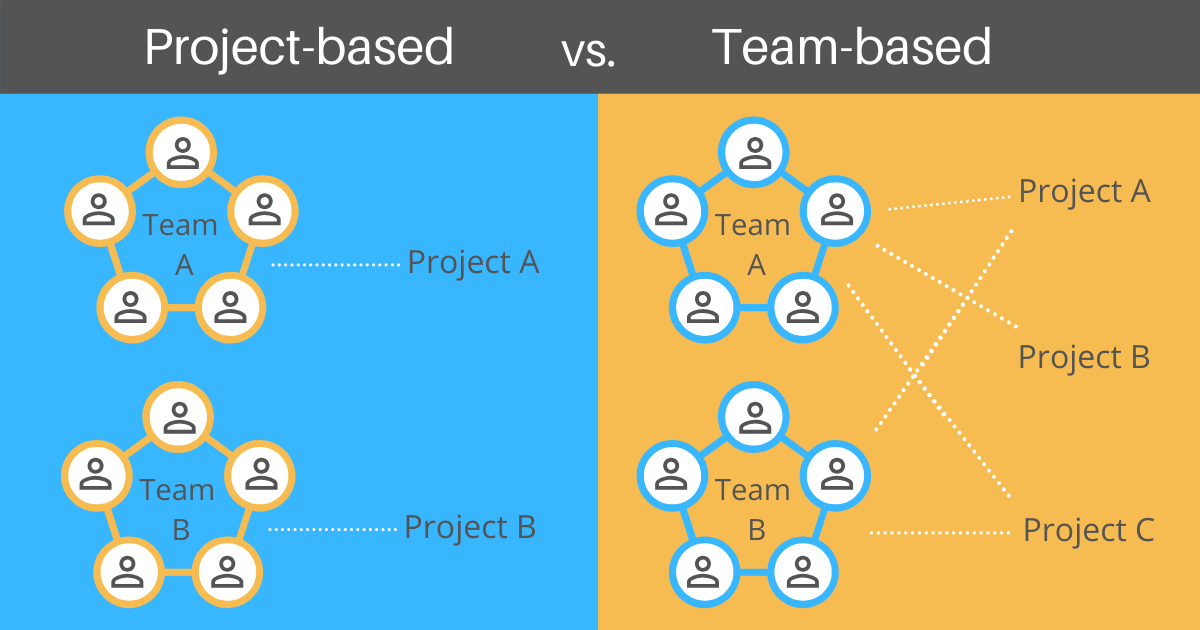There are numerous software development projects available for the custom software development company to outsource these days. All of these projects are worked upon by numerous developers. Now, these could be local or from around the globe, they could be working for an organization that is developing the software. Others could be working for distinct firms and some might work on their own.
So, when there are such a large number of people or developers involved, the success of the software development projects depends on how successfully the custom software development company manages all these teams.
So now if you are wondering about how can you outsource software development projects of your company then go through this helping guide. Here we will tell you the pros and cons of both the type of organizational models. Along with some best practices and tips for you to go through and have a better understanding.
Organizational model: Project-based
One project of the software development services is assigned to one team. Now this team may consist of people having all the skills required for the successful completion of the project. It may include software developers, business analysts, designers, software testers, and project managers, etc.
Merits of Project-based model:
- Cohesive communication
- Cross-functional teams
- Varied thought processes
- Working single-mindedly
Cohesive communication
Assigning one project manager for the team results in better communication amidst the client and the team. A clear and precise communication furthermore helps in improving the efficiency and productivity of the team for the project at hand. And it also helps to remove the roadblocks, if any.
Cross-functional teams
The team comprises people with a varied set of skills. These distinct skills can be used in the successful development of the software.
Varied thought processes
As the team is made up of people with different skill sets, communication among these professionals can lead to innovations, new opportunities, and the discovery of best practices.
Working single-mindedly
Focusing on one project at a time leaves no room for distractions. Employers can devote all their minds and energy to the successful completion of the software development project. They may not require Saas development services.
Demerits of Project-based model:
- Narrowed vision
- Management skills
- Replacing team members
Narrowed vision
The team has been working on one single project, so they might not be able to see the bigger picture. It is possible that they might not understand how their project will affect the cohesive output.
Management skills
If the project manager of the team does not possess the best skill set then the team may be forced to work on less important projects. This could result in the unsuccessful completion of the project.
Replacing team members
It will not be easy to replace a member of the working team. Although replacing them on the basis of their skill set is easier than on the basis of their knowledge and participation in the project.
Therefore, such a model might not be the best fit for all the projects of software development. And maybe, that is why there exists another type model called team-based.
Organization model- Team-based
In the team-based model, one remote or distributed team is given two or more projects of the software development services to work on simultaneously. For example, a team of workers or developers works for your mobile application development as well as web application development.
Merits of Team-based model:
- Agility
- Better usage of skillset
- In-depth understanding of business
Agility
Such type of model renders a flexible and agile team. This team can easily pivot to another project while awaiting the feedback of the client on one project. This way they can work on the development of multiple projects.
Better usage of skillset
In a team-based model, workers get an opportunity to leverage their skills for multiple projects. Plus they also get to share their skills with others and explore theirs. Such an advantage is not possible in the project-based model. Plus, the developers might also learn to use Saas development services in a better way.
In-depth understanding of business
Working for more time for a particular or specific company leads to a better understanding of their business. And this working across multiple projects is bound to increase their knowledge exponentially.
Demerits of Team-based model
- Communication hindrances
- The end result might get stuck
- Giving proper time and attention
Communication hindrances
Communication is at its best only when it is a singular two-way channel. But in a team-based model, several teams are working on one single project from various locations, each having its own time zone. This can lead to inefficient communication.
The end result might get stuck
It is possible that if communication among the teams working on multiple projects breaks down, then the completion of all the projects might get stuck. This will cause unnecessary delays in the succession of the projects.
Giving proper time and attention
When working on multiple projects it is necessary for the workers to devote time to each project aptly. This will be challenging as there is a need to make a perfect decision first regarding how much time should be given to a project.
So, like the project-based model, the team-based model also has some cons. Hence even though both the types of organizational models have some pros and cons, they might fit perfectly in certain work situations. Now, let’s end with when you should use these two models.
When to use either of these two: Project-based VS Team-based
Project-based
- For projects with flexible deadlines
- For projects that require distinct roles
- For projects that need an end-to-end management
Team-based
- When augmenting your IT staff for Saas application development
- For related and ongoing projects
- For projects whose discovery and requirements are completed
Summing it up
So above we have described the two types of organizational models along with their pros and cons. Then we cited some situations or projects for when these two models should be used.
But apart from the mentioned “when” there can be numerous other situations or projects for which you need to make a choice between the two types of models.
At such a time weigh their pros and cons once again according to your resources and then make a choice, which could be for a Saas application development project or any other.





 United States
United States United Kingdom
United Kingdom India
India Canada
Canada Singapore
Singapore



































